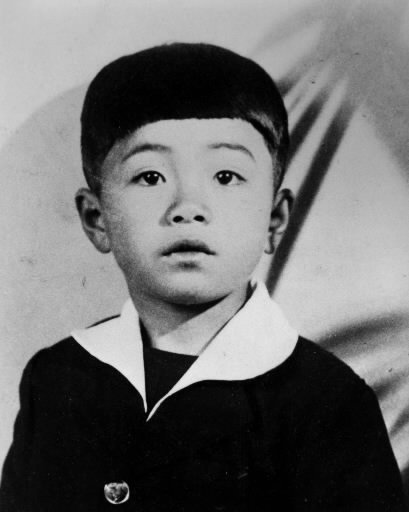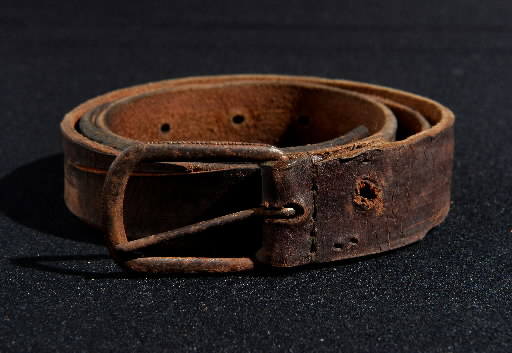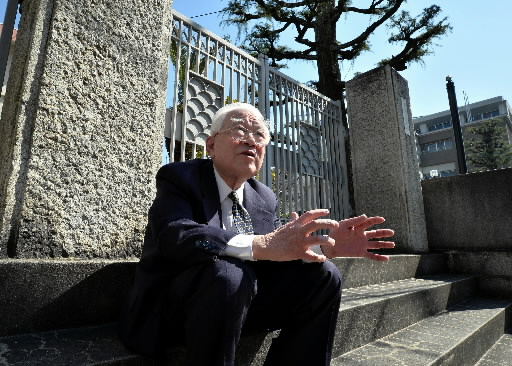Hiroshima: 70 Years After the A-bombing: 12-year-old “war dead” 2
Jul. 9, 2014
Brother’s leather belt
Clutching gift received upon entering school
At around 2 p.m. on August 6, 1945, Osamu Nanko, 12, a first-year student at First Hiroshima Prefectural Junior High School (now Kokutaiji High School) arrived at his home in Ujina-cho (Minami Ward) on the back of a stranger’s bicycle. He had been working as a mobilized student on the demolition of buildings near city hall in Zakoba-cho (now Kokutaiji-cho, Minami Ward) when the atomic bomb was dropped. As he made his way home, he was picked up by the man on the bicycle.
Osamu’s brother Masaru, two years older, was working as a mobilized student at Toyo Kogyo (now Mazda) and had gotten home first. He couldn’t recognize his brother. “Is that Osamu?” he asked. Osamu’s uniform had been burned off, and he was clad in only his underwear. He was clutching the leather belt he had been given to mark his entrance to junior high school.
“Nearly 70 years have passed, but I’ll never forget it,” said Masaru, 83, a resident of Fuchu-cho in Hiroshima Prefecture.
“He couldn’t open his mouth, so at the end he moved his arms as if signaling by semaphore,” Masaru said. “I think he wanted to say, ‘Goodbye and thanks.’” Osamu was a member of an organization for boys who were interested in the navy. Masaru was considering entering a newly established officer training course at the naval academy.
Osamu died that evening with his mother Shizuko, 38, at his side. That night, his eldest brother Takashi, 18, returned home. A student at Hiroshima Normal School, Takashi had been mobilized to work at the Kure Naval Arsenal. Their father Shiro, 44, a postal worker, had been drafted.
On August 7, Masaru and Takashi cremated Osamu’s body in a vacant lot next to the military supply depot (Minami Ward). “The demolition of buildings had been going on in that area too, so it was easy to find scrap wood to burn his body with,” Masaru said.
According to records compiled by an association formed by the families of victims of Hiroshima Prefectural Junior High School, a total of 353 students from the school, including 288 first-year students, were killed in the atomic bombing. That day two groups of Masaru’s third-year classmates set out to work on the demolition of buildings, one group in Koami-cho (Naka Ward) and the other in Tsurumi-cho (Naka Ward). All of the members of the group that went to Koami-cho were killed. The members of the other group were badly burned.
Masaru listened to the August 15 broadcast by the emperor announcing the end of the war at the family home, which had escaped the fire. Rather than chagrin, he felt relief at having survived.
The school reopened, making use of buildings that had survived the fire as well as buildings it rented on the outskirts of the city, and in January 1946 Masaru went back to school. “I was really happy to be able to study,” he said. Prior to that, after first entering the school, he engaged in military drill and worked in construction as a mobilized student. From the second half of his second year, he manufactured Type 38 rifles (the standard infantry rifle of the Japanese Imperial Army) and pistons for military aircraft at Toyo Kogyo.
Classes were conducted in simple structures that were erected on the burned-out site after the students cleared it themselves. In 1949 Masaru enrolled in the new Faculty of Politics and Economics at Hiroshima University. He was determined to work in his hometown following graduation and accepted his first job offer, which was from Hiroshima Bank.
“Every local company had been hard hit by the A-bombing, but they were all eager to get back on their feet, so working in finance was very worthwhile,” Masaru said. His career encompassed both Hiroshima’s recovery and Japan’s rapid economic growth, and he retired from the bank as a senior managing director. For three years, starting from 1994, the year the Asian Games were held in Hiroshima, he served as director of the Hiroshima Stock Exchange.
His four children are grown, and his wife died in 1999. Osamu’s belt was donated to the Peace Memorial Museum in 2004. Masaru’s mother, who lived with him, took the belt out of the Buddhist altar and stroked it gently. Since her death five years ago at the age of 102, Masaru has lived alone. He has not talked much about the A-bombing over the years. He agreed to be interviewed because he realized people were beginning to forget not only the war that led to the A-bombing but also the postwar years.
“More and more politicians know nothing but prosperous times, and they’re making all kinds of bold statements. If my brother and the other students could come back, I’m sure they would say, ‘Is this OK?’” he said softly but earnestly.
(Originally published on April 7, 2014)










